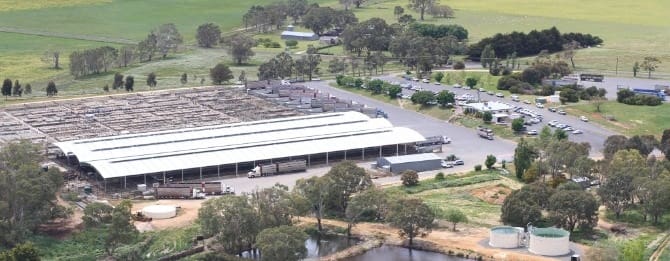
The Mt Gambier saleyards have lost sheep to Victoria due to the SA footrot management program.
SOUTH Australian livestock agents have suggested building saleyards in Victoria to avoid the state government’s footrot monitoring regimen, Sheep Central has been told.
Some producers fearful of PIRSA’s control measures in South Australia – where footrot is a notifiable disease — are not consigning lambs to the Naracoorte and Mt Gambier saleyards.
Some SA producers have instead consigned lambs and sheep direct to abattoirs or to the Horsham, Hamilton, Bendigo or Ballarat saleyards. The SA saleyards have also noticed a drop in lamb numbers from far western Victorian producers who previously sold stock in the Mt Gambier and Naracoorte saleyards. Mt Gambier agents have also considered having separate terminal-only and restocker-only sales.
Agency sources said PIRSA is being “very meticulous” with inspections of sheep in saleyards – tipping sheep up, swabbing hooves – and then quarantining producers’ properties.
“And a lot of the results come back inconclusive, but then you are still quarantined.
“It takes a couple of years for you to get out again,” an agent said.
“You’ve got to wait until next Spring, bring all your sheep into the (property’s) yards, tip them all up and prove that you don’t have it.”
“It’s the reality of the monitoring and what it is doing to the saleyard system,” the agent said.
“It’s not fixing the problem, all it is doing is driving people away for the Naracoorte Regional Livestock Exchange and the Mt Gambier Livestock Exchange.”
Agents said producers are hiding from the monitoring and an education and support management model was needed rather than a punitive system.
“It’s just hurting the yards and it’s scaring the lambs away – it’s only a two-hour trip to Hamilton.
“We had 16 people pinged in a week late last year and the next week there were nine B-doubles (of lambs) from the south-east (of SA) in the Hamilton saleyards.”
According to the PIRSA website, if a flock has been detected with footrot, there are movement restrictions that apply under the South Australian Livestock Act 1997.
When there is a suspicion a flock has severe virulent footrot, sheep cannot be sold to other graziers, must not be sold in a public market and must not be allowed to stray onto public roads or neighbouring properties. Sheep with footrot can be sold directly to an abattoir for slaughter or slaughter through an approved feedlot. They must be fit to load – being able to bear weight on all four hooves prior to transport.
In South Australia, footrot is classified as inflammation of the interdigital skin and potential under-running of the hoof caused by the bacteria Dichelobacter nodosus (D. nodosus). Footrot is a notifiable disease and suspicion of any form of footrot must be reported immediately, according to PIRSA.
SA footrot program review planned

The Naracoorte saleyards has also lost sheep to Victoria due to footrot monitoring.
Livestock SA project officer Mandy Bowling told a regional meeting at Keith last week that the footrot management program in South Australia is industry-funded and the Department of Primary Industries and Regions (PIRSA) is responsible for carrying it out.
She said Livestock SA had received concerns about PIRSA’s footrot compliance monitoring in the Mt Gambier and Naracoorte, leading to producers choosing to sell stock in Victorian saleyards.
She said Livestock SA has been funded to do a 12-month review of the program, working with PIRSA on a project plan to look at the current program and alternatives, and potentially changing levels of compliance required in some regions and the levels of education and support provided. PIRSA has also contributed some funding.
She said a consultant will be engaged to consult with producers and groups around the state, about the current program and potential alternatives, as well as the economic impact analysis of a compliance versus buyer beware system.
“The aim is to have that work completed by the Sheep Industry Fund meeting in 2024, which I think is about May and there will be a recommendation put forward from that work around what program will work best in South Australia.”
However, Ms Bowling said because the issue of SA sheep being sold into Victoria remained, PIRSA has spoken to Livestock SA and the Naracoorte and Mt Gambier saleyards and their agents about potentially changing the compliance program for this season.
“The hasn’t been confirmed yet, there are still conversations happening, but it is pretty close to something being signed off and when it is we will be communicating with people in the region exactly what that means.”
She said the footrot compliance program for south-west South Australia could change this season and again next year.
Ms Bowling said at the moment it is legislated that footrot is a notifiable disease in South Australia, meaning producers who know their sheep have the disease have to tell PIRSA, though not necessarily their neighbor.
“We don’t know if that will change.”
Ms Bowling it is hoped that the review will explain how much might need to be invested to eradicate the disease. She said the review will also be a pilot that would be used in economically analyzing other disease management programs.
Agents want Victorian footrot system in Naracoorte and Mt Gambier

SA MP Nick McBride at the Livestock SA regional meeting in Keith last week.
South Australian MP and producer Nick McBride said after last year’s “big big Spring,” a lot of sheep from producers going into the Naracoorte and Mt Gambier saleyards were found to have “scald (benign footrot), or potentially scald or potentially then footrot.”
“Their whole properties were quarantined and they had to prove that they didn’t have footrot.
“This scared people away from those markets, the agents won’t be able to get them back to the South Australian markets so they are now talking about going into Victorian markets,” he said.
“So the agents are then threatening to say then we will go and build a Victorian market system, because if we don’t be able to get any sheep sold through the saleyard system.
“The request by the agent is that they want the footrot management system and criteria in Victoria brought into South Australian saleyards, only in Naracoorte and Mt Gambier, if the industry is willing.
“It’s just talk, it’s an idea and it may solve that problem.”
A PIRSA statement said the department has been discussing with the sheep industry concerns raised regarding the South Australian industry-funded footrot program, including impacts relating to the south-east saleyards. Further information regarding any modifications or future activities will be made available once arrangements are finalised, PIRSA said.



HAVE YOUR SAY